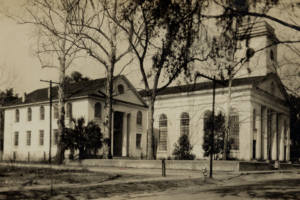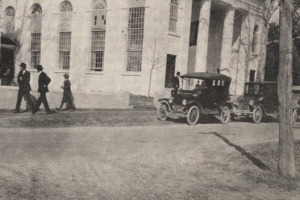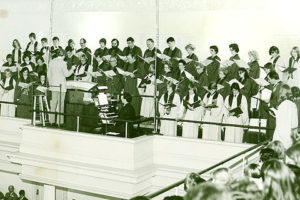Our History
Long before the American Revolution, Baptists, then called dissenters, were preaching in this village where the Anglican Church was the established faith. Welcome to The Baptist Church of Beaufort, a historic congregation with improbable links to the earliest Baptist conventions in America. The Baptist Church of Beaufort was a “branch” of Euhaw Baptist Church on the mainland when Rev. Henry Holcomb became the first resident mission pastor in 1795. Holcombe later organized Savannah First Baptist, then accepted the influential pulpit of Philadelphia First Baptist. There, in 1814, he hosted a national gathering of mission-minded men who formed the first Baptist congress in the land, the Triennial Convention.
Thomas Jefferson was president when we formally constituted as The Baptist Church of Beaufort in 1804. An early convert was the pastor’s cousin, attorney William B. Johnson, who changed careers and stepped onto the Baptist scene. He helped start then Furman Academy and Southern Seminary, in addition to several important South Carolina churches. For 27 years he was president of the South Carolina Baptist Convention, the first organized state convention. Not only was Johnson the only man present at both the founding of the Triennial Convention and the Southern Baptist Convention, he was the only man to serve as president of both. W. B. Johnson, baptized in Beaufort, is considered the architect of the 1845 Southern Baptist Convention.
Andrew Jackson was president during the Beaufort Great Revival of 1831. This was a landmark event for The Baptist Church of Beaufort and St. Helena Anglican with spiritual reverberations felt for generations. Among the many converted, six lawyers and the Beaufort College President entered the ministry. Two became Episcopalian bishops, and Harvard-educated Richard Fuller abandoned his law practice to pastor The Baptist Church of Beaufort. On his 1833 ordination day he baptized 107 candidates. Led by the wealthy Fuller, the present sanctuary was completed in 1844 at a cost of $17,000. Since most of the 2,200 church members were slaves, Fuller raised funds through preaching engagements in surrounding states and gifts from his own fortune. This building is considered one of the finest examples of Greek Revival architecture in the country, and skilled slave artisans created the molded plaster decorations. Church members and townspeople paid $12 to $30 to rent pew boxes; the least expensive rows were the first one and the last three. The architect is undocumented, but the design is remarkably similar to the Second Baptist Church of Charleston, under construction at the same time, designed by the prominent Edward Brickell White. Dr. Fuller gained renown as a gifted nineteenth century orator, the “Prince of Preachers,” and chaired the by-laws committee for the new Southern Baptist Convention in 1845. He delivered the first annual convention sermon, became its third president, and preached at every SBC annual meeting for the next 30 years. In 1847 he moved to a struggling church in Baltimore. As a southern, slave-owning, preacher he wanted to look at slavery “with a calm and impartial judgment” from a border state. There, Fuller built two strong churches, and in 1869 he baptized and mentored a headstrong young woman named Annie Armstrong. Her zeal and fierce focus would prepare the Woman’s Missionary Union for 20th century tasks.
At one time, leading Baptist churches in Atlanta, Philadelphia, Washington, Charleston, Baltimore, and Houston were all led by Beaufort-trained pastors. By November 1861 when federal forces occupied Beaufort and white residents fled, this church counted 166 white members and 3,557 African-Americans. For the next four years this was a Union town and the church building was a hospital for black soldiers. Graffiti is still visible on the belfry beams and a wall in the sanctuary. When a remnant reclaimed their chapel in 1866, a faithful black deacon, now free, brought in the communion silver he had hidden in his feather bed. Old pews were reinstalled without their doors, and the communion table was recovered from Charleston.
Difficult years fraught with financial problems continued for decades before a Sunday School building was added in 1917. More educational facilities came in 1949, 1957, and 1985. The sanctuary ceiling was meticulously restored in 1953, using 98% of the original rosettes. Hurricane Gracie in 1959 damaged roof, walls, and carpet but spared the precious ceiling.
The original 1844 church plan was completed in 1962 when a steeple was added, the gift of Mr. and Mrs. John M. Trask. The 1844 bell still rings for Sunday services and weddings.The most comprehensive restoration to date took place in 1997-1998. The west wall was pushed back 29 feet, the sanctuary was enlarged to create a new chancel with more flexible pulpit area and a historic pipe organ with 39 ranks. Seventy-five percent of the exterior stucco was matched and replaced, and interior walls underwent extensive renewal. Historic colors – seven shades of white – were used, and original heart pine floors revealed for the first time in memory. The cost of the 18 month project was over $2,200,000.
Our church has established missions or churches at Port Royal, Hilton Head, St. Helena, Laurel Bay, Grays Hill, Shell Point and Lady’s Island. As noted, The Baptist Church of Beaufort was in existence long before the Southern Baptist Convention.








